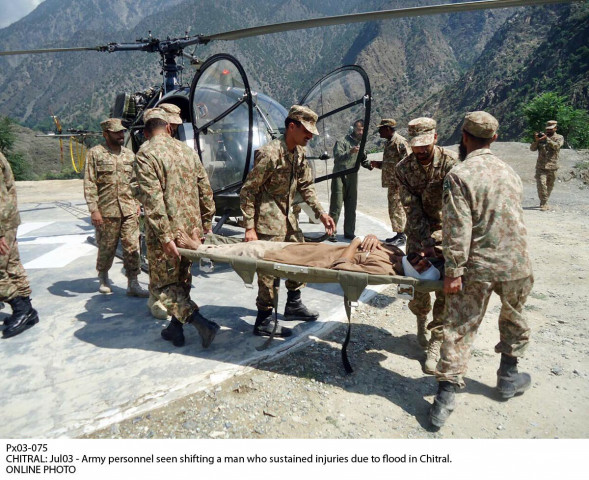
The area lost three-fourths of its infrastructural development in 2015. While the emphasis this year has once again been on disaster management instead of adaptive measures, 31 people are missing and 37 houses seven have been destroyed. Officials say these structures were in the path of a water channel induced by the flash floods.
Although the area suddenly gained prominence on Saturday night for the provincial government after rainfall washed away a village in Ursoon, the region is difficult to access at the best of times.
The damage to life and property is extensive even though a monsoon contingency plan was prepared and funds were released.
A government official, authorised to survey the region around Ursoon, told The Express Tribune the entire village was built on a narrow strip and was susceptible to flash floods.
“Most of the settlements are encroachments,” he said. “Had these people been evacuated earlier, even by force, it could have saved lives.”
Since 2010, when a massive flood almost set K-P back 20 or 30 years in terms of development, part of Chitral kept disappearing.
The increase in weather anomalies due to global warming is something that has to be taken into consideration, PDMA Director General Amir Afaq told The Express Tribune.
There is a phenomenal increase in flash floods and they have intensified with time because not only are glaciers melting, the soil is also eroding.
This is bringing down massive boulders and creating a large amount of lethal debris.
“It has been happening since 2013,” he said. “Last year, the flooding began in the second and third week of July. In 2016, it has started in the first week.” The official said people have to be convinced not to build abodes in the path of water streams.
There were 0.3 million people displaced due to glacial lake outburst floods in 2015. In the monsoon contingency plan, the same figure was estimated in a worst-case scenario resulting from floods this year.
However, the infrastructure damages of 2015 had yet to be covered completely.
“One year into district’s recovery plan, which was phased into three distinct categories, the monsoons are back,” the official said. The plan ranged from short to long-term goals and spans over a period of 24 months, costing the exchequer $77.167 million.
“Let alone reconstruction and rehabilitation after last year. We were told in the presence of Prime Minister Nawaz Sharif that an early warning system will be set up,” Chitral lawmaker Sardar Hussain told The Express Tribune.
“Although we have been submitting resolutions in the assembly to bind the government to do something about the floods, there hasn’t been any meaningful progress,” he complained.
Hussain added the least the government could do was crack down on the timber mafia. “Arandhu [tehsil] is naked,” he said. “What does one expect with water pouring down from 6,000 metres?”
There were 48 bridges, 30 schools, 10 power houses, 29 kilometres of road and 154 schemes destroyed last year. Locals say there is hardly any significant recovery since then. While experts suggest climate change adaptation and mitigation across the globe, K-P, one of the worst affected areas, has not implemented a viable strategy to counter the weather.
Published in The Express Tribune, July 4th, 2016.
1726054615-0/OpenAI-(2)1726054615-0-270x192.webp)











COMMENTS
Comments are moderated and generally will be posted if they are on-topic and not abusive.
For more information, please see our Comments FAQ